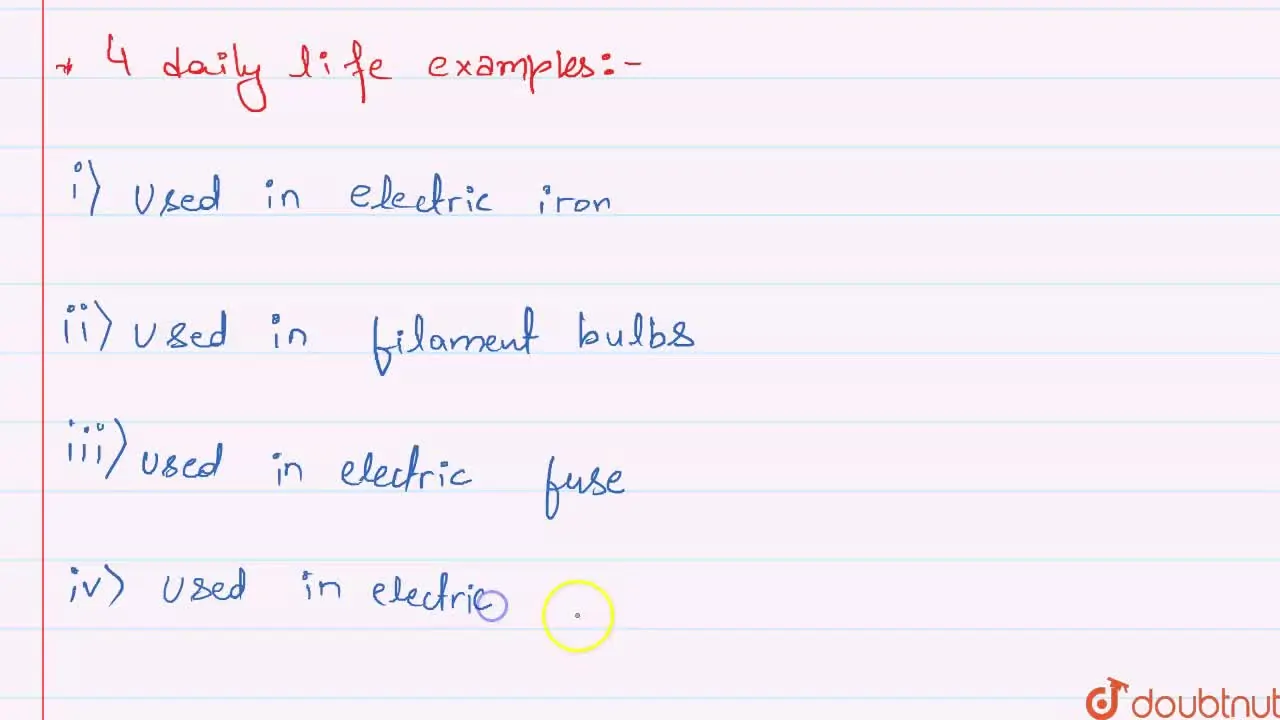What is Joule's heating effect ? How can it be demonstrated experimentally ? List its four applications in daily life.
The heating effect of current is defined by Joules law of heating. It states that the heat H produced by a resistor of resistance R due to current flowing through it for time t is H=I2Rt. It is also called ohmic heating and resistive heating.
In a conductor when an electric field is applied across its ends, the free electrons available in it start drifting opposite to the direction of the electric field. These electrons collide with the atoms which have lost the electrons.
As a result of these collisions some energy of the electrons is transferred to the atoms which vibrate violently as they gain energy. Thus, heat is developed in the conductor. Greater the current, greater will be the rate of collision and so greater will be the heat produced.
The four applications using heating effect of current are as follows
(i) room heater (ii) electric bulb
(iii) electric iron (iv) electric fuse
Related Playlists
Similar Questions
List four examples of thermal expansion in daily life.
View SolutionWhat is Tollens' reagent ? How can acetaldehyde and acetone be distinguished with its help?
View SolutionCoordination compounds plays many important roles in animals and plants. The are essential in the storage and transport of oxygen as electrons transfer agents as catalysts and in photosynthesis Wide range of application in daily life takes place through formation of complexes Photographic fixing qualitative and quantitative analysis purification of water metallurgical extraction are some specific worth mentioning
Lead poisoning in the body can be removed by
(a) EDTA in the form of calcium dthydrogen salt
(b) Cis-platin
(c ) Zeisse' s salt
(d) DMG .View SolutionWhat is Tyndall effect ? Mention one of its applications.
View SolutionState what is apomixis. Write its significance. How can it be commercially used ?
View SolutionState what is apomixis. Write its significance. How can it be commercially used ?
View Solution(a) Describe briefly, with the help of suitable diagram, how the transverse nature of light can be demonstrated by the phenomenon of polarization.
(b) When unpolarized light passes from air to a transparent medium, under what condition does the reflected light get polarized?View SolutionWhile teaching the chapter " Our Environment " the teacher stressed upon the harmful effects of buring of fossil fuels, plastic, paper etc. The students noticed the extensive use of plastic and polythen in daily life, which can be avoided and the surroundings can be kept clean. they decided to make their school " plastic and polythene" free and motivated each other for its minimum use.
(a) Why should the use pf polythene and plastic be reduced in daliy life ?
(b) In what ways the students would have avoided the use of plastic and polythene in their school ?
(c) How the students would have motivated each other for the success of their decision ?View SolutionA liquid is in equilibrium with its vapour in a sealed container at a fixed temperature. The volume of the container is suddenly increased.
a. what is the initial effect of the change on vapour pressure?
b. How do rates of evaporation and condensation change initially?
c. What happens when equilibrium is restored finally and what will be the final vapour pressure?View Solution(a) Earth can be thought of as a sphere of radius 6400km. Any object (or a person ) is performing circular motion around the axis on earth due to earth's rotation (period 1 day ). What is acceleration of object on the surface of the earth (at equator ) towards its centre ? What is its latitude θ ? How does these accelerations compare with g=9.8m/s2?
(b) Earth also moves in circular orbit around sun every year with an orbital radius of 1.5×1011m. What is the acceleration of earth ( or any object on the surface of the earth ) towards the centre of the sun ? How does this acceleration compare with g=9.8ms2?View Solution


